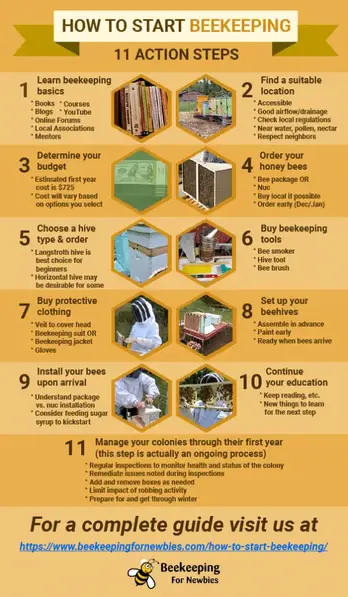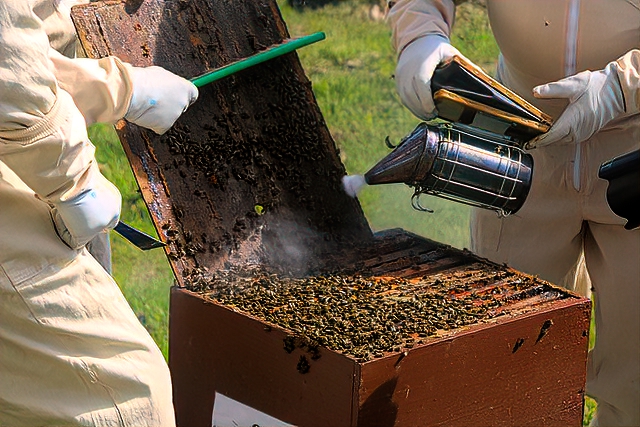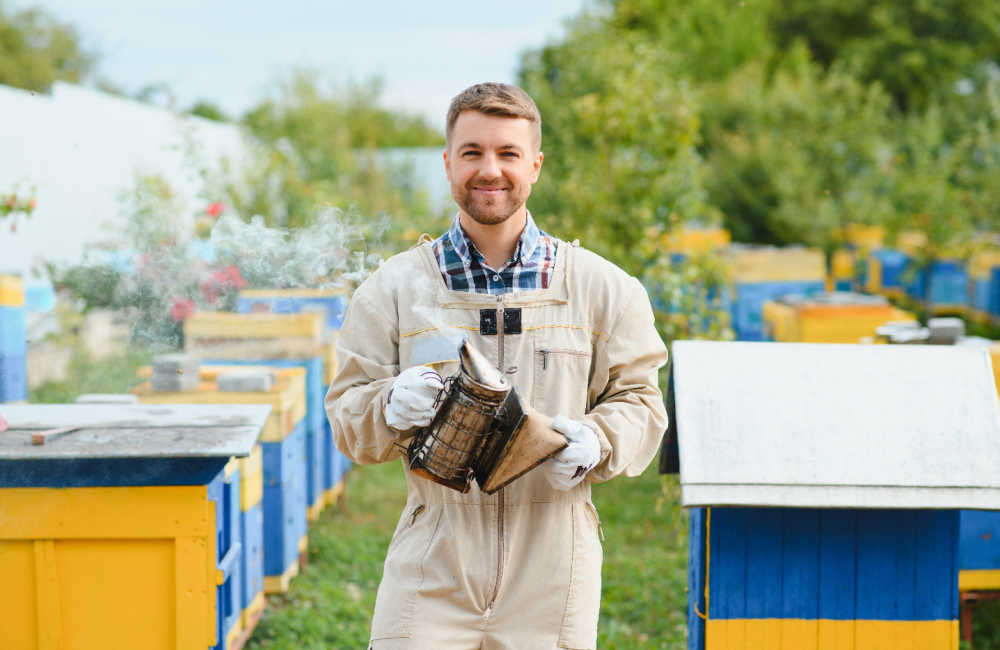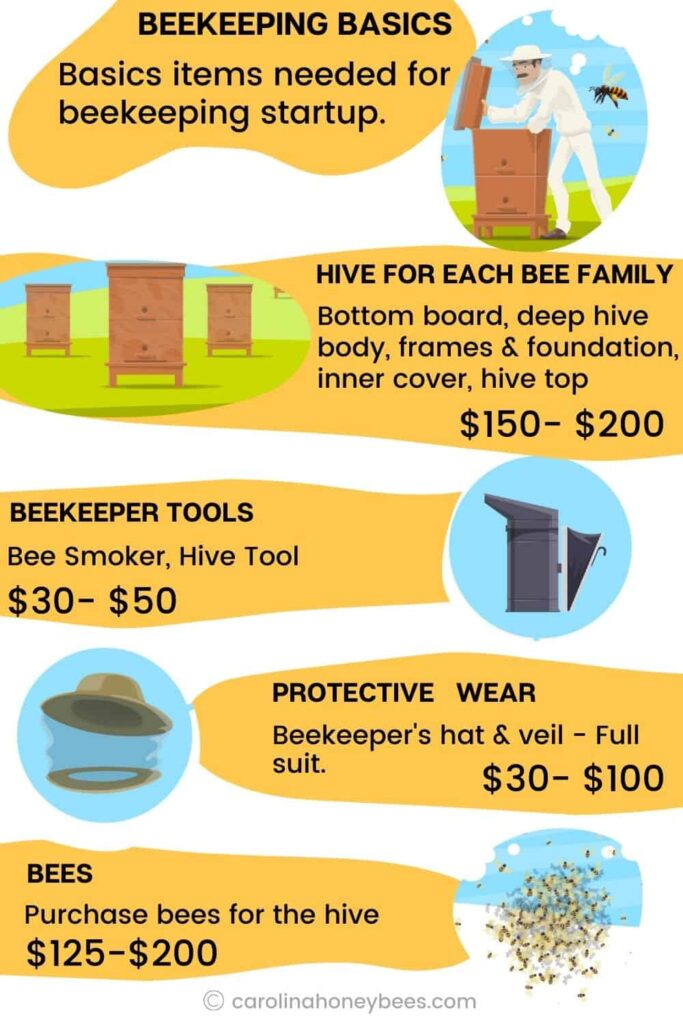
Interested in starting beekeeping but unsure about the cost? Look no further! This article will give you a brief overview of how much it costs to start beekeeping. From the essential equipment to the initial investment, we will break down the expenses involved in this fascinating hobby. So, if you’re ready to explore the world of beekeeping and want to know what it takes financially, keep reading!
Choosing the Right Equipment and Supplies
Types of Hives
When it comes to beekeeping, choosing the right type of hive is crucial for the success of your colonies. The two most common types of hives are the Langstroth hive and the top-bar hive. The Langstroth hive is the most popular choice among beekeepers due to its modular design, allowing for easy expansion and maintenance. On the other hand, top-bar hives are more natural and provide a hive design that mimics the natural structure of a beehive. Ultimately, the choice between the two will depend on your personal preferences and the specific needs of your bees.
Frames and Foundation
Frames and foundation play a vital role in providing structural support and guidance for the bees as they build their honeycomb. It is important to choose high-quality frames and foundation that are durable and resistant to warping. Most beekeepers opt for plastic frames and foundation, as they are more cost-effective and easier to maintain. However, some beekeepers prefer to use wax foundation, which is more natural and allows the bees to build their comb with pure beeswax.
Smokers
A smoker is an essential tool in beekeeping, used to calm the bees and make them less defensive during hive inspections. Smokers work by producing cool smoke that disrupts the bees’ communication and triggers them to gorge on honey, which makes them less likely to sting. When choosing a smoker, make sure to select one that is easy to use and produces a consistent smoke output. Additionally, it is important to have a good supply of smoker fuel, such as pine needles or wood chips, to keep your smoker going throughout your beekeeping sessions.
Protective Clothing
Beekeeping can be a stinging hazard, so investing in the right protective clothing is crucial for your safety. A beekeeping suit or jacket with a veil is the most common choice for beekeepers. The suit should be made of a durable and breathable material, such as cotton, that provides full coverage and protection from bee stings. Additionally, wearing gloves and boots made specifically for beekeeping is also highly recommended. Remember, your safety is paramount, so don’t skimp on quality when it comes to protective clothing.

Tools and Equipment
To effectively manage your bee colonies, there are several essential tools and equipment that every beekeeper should have. These include a hive tool for prying open hive boxes, a bee brush for gently moving bees off frames, a queen excluder to prevent the queen from laying eggs in certain hive sections, and a beekeeping knife or uncapping fork for extracting honey. Additionally, having a good quality bee brush, a queen catcher, and a honey extractor will make your beekeeping tasks much easier and more efficient. Invest in sturdy and reliable tools to ensure smooth beekeeping operations.
Cost of Bees
Different Bee Species
When starting beekeeping, you’ll need to decide which species of bees to keep. The most common species used for beekeeping are the European honey bee (Apis mellifera) and the Italian honey bee (Apis mellifera ligustica). These species are known for their productivity and docile nature, making them ideal for novice beekeepers. However, there are other species and local varieties available depending on your location and preferences. Research the characteristics and behavior of different bee species before making your decision.
Packages vs. Nucs
When acquiring bees, you have two main options: purchasing packages or nucs (nucleus colonies). Packages consist of a 3-pound box of bees (around 10,000 bees) with a queen, whereas nucs are small established colonies with a queen, worker bees, brood, and honeycomb. Packages are usually cheaper and easier to transport, making them a popular choice for beginner beekeepers. On the other hand, nucs offer a head start as they already have established brood and resources. Consider your budget and goals when deciding between packages and nucs.
Buying vs. Catching Swarms
Another way to acquire bees is by catching swarms. Swarming is a natural process in which a colony splits and the swarm, led by the queen, flies away to find a new home. Catching a swarm can be exciting and cost-effective, as it allows you to acquire bees for free. However, capturing a swarm requires knowledge and skills, as well as the appropriate equipment. If you are a beginner, it is recommended to purchase bees or nucs initially and gain experience before attempting to catch swarms.
Bee Feeding and Medication

Sugar Syrup
Feeding bees is necessary during periods of nectar scarcity or when establishing new colonies. Sugar syrup is commonly used as a supplemental food source for bees. The ratio of sugar to water in the syrup can vary depending on the purpose. A 1:1 ratio of sugar to water is typically used for promoting brood production and colony growth, while a 2:1 ratio is preferred for winter feeding to provide more energy. Ensure that the sugar used is pure and free from additives.
Pollen Substitute
Bees require a balanced diet to thrive, and pollen is an essential component of their nutrition. However, in some cases, there may be a shortage of pollen sources in the vicinity, especially during early spring. In such situations, providing a pollen substitute can help ensure that your bees have enough nutrients. Pollen substitutes are available commercially and come in various forms, such as patties or powders. Follow the manufacturer’s instructions for proper usage and feed your bees accordingly.
Mite Treatments
Varroa mites are a common pest that can weaken and destroy bee colonies if left untreated. Treating your hives for mites is an important part of beekeeping maintenance. There are various methods and treatments available to control mite infestations, including organic options such as formic acid or essential oils, as well as synthetic chemical treatments. Consult with experienced beekeepers or local beekeeping associations to determine the most effective treatment options for your region and beekeeping practices.
Hive Location and Set Up
Site Selection
Choosing the right location for your beehives is crucial for their health and productivity. Ideally, select a site with good access to sunlight, shelter from strong winds, and a nearby water source. Avoid areas prone to flooding or with excessive shade, as bees thrive in warm and dry conditions. Additionally, consider the proximity to neighbors and potential disturbances. Ensure that your bees have a clear flight path without interfering with human activities.

Hive Stand
A sturdy hive stand is essential to elevate your hive off the ground, allowing for better airflow and reducing the risk of water damage. Hive stands are available in various types, including wooden stands or metal stands. Choose a stand that is durable, easy to assemble, and provides the appropriate height for your convenience during hive inspections and maintenance. Proper hive elevation helps prevent moisture buildup and keeps the hive secure and stable.
Supplementary Feeders
Supplementary feeders are used to provide supplemental food to your bees when natural forage is limited. There are different types of feeders available, such as entrance feeders, boardman feeders, and top feeders. Each feeder has its advantages and considerations regarding ease of use, accessibility, and bee behavior. Select a feeder that best suits your needs and consult with experienced beekeepers for recommendations in your specific beekeeping context.
Apiary Registration and License
Before setting up your beehives, make sure to check the local regulations regarding beekeeping. Some areas may have specific requirements, such as registration and obtaining a license to keep bees. It is important to comply with these regulations to ensure the health of your bees and avoid potential legal issues. Contact your local agricultural or environmental department to inquire about the necessary permits or licenses needed to operate your apiary.
Training and Education
Beekeeping Courses
Taking beekeeping courses is a valuable way to gain knowledge and practical skills necessary for successful beekeeping. These courses are offered by universities, agricultural extension programs, local beekeeping associations, and online platforms. They cover a wide range of topics, including hive management, bee biology, pest and disease control, and honey harvesting. Joining a beekeeping course can help you become a confident and well-informed beekeeper, ultimately increasing the chances of success in your beekeeping journey.

Workshops and Webinars
Attending workshops and webinars conducted by experienced beekeepers and beekeeping organizations is another excellent way to enhance your beekeeping knowledge and skills. These events often focus on specific topics or techniques, allowing you to dive deeper into areas of interest. Workshops and webinars provide opportunities for hands-on training, networking with other beekeepers, and obtaining practical tips and insights that may not be covered in general beekeeping courses.
Books and Resources
Reading books and accessing online resources dedicated to beekeeping can significantly contribute to your beekeeping education. There are numerous informative books, magazines, and websites available that cover various aspects of beekeeping, from beginner guides to advanced beekeeping techniques. Look for trusted authors and resources that provide practical advice and comprehensive information. Building your own beekeeping library and regularly referring to reliable resources will ensure that you have a wealth of knowledge at your fingertips.
Honey Extraction and Processing
Extractors
Extracting honey from the comb is a crucial step in beekeeping. Honey extractors are mechanical devices that spin or centrifuge the frames, separating the honey from the comb. There are manual and electric extractors available, each with its pros and cons. Manual extractors are more affordable but require manual effort, while electric extractors are more expensive but offer convenience and faster processing. Consider the size of your apiary and your budget when selecting an extractor that meets your needs.
Honey Storage Containers
Once the honey is extracted, it needs to be stored in appropriate containers to maintain its quality and freshness. Food-grade plastic or glass containers with tight-sealing lids are the most common choices for honey storage. Avoid using metal containers, as they can react with the honey and affect its flavor. Ensure that the containers are clean and dry before pouring the honey into them. Label the containers with the date and type of honey to keep track of the batches.

Bottling and Labeling
Bottling honey is not only about function but also aesthetics. Choose attractive and practical containers for bottling your honey. Consider the size and shape of the bottles, as well as the labeling requirements in your area. Labeling is an essential aspect of honey packaging, providing crucial information such as the producer’s name, honey variety, harvest date, and any applicable allergen warnings. Adhering to food safety regulations ensures that your honey is properly labeled for consumer safety and compliance.
Food Safety Regulations
When processing honey for sale or personal consumption, it is important to adhere to food safety regulations. Follow the guidelines and regulations set by your local health department or food authority to ensure that your honey is processed and stored in a clean and safe environment. This includes maintaining hygiene in your extraction and bottling processes, proper equipment sanitation, and appropriate storage conditions. Familiarize yourself with the applicable regulations to avoid any legal issues and promote consumer confidence in your honey products.
Insurance and Legal Requirements
Liability Insurance
Beekeeping, like any agricultural enterprise, carries certain risks. To protect yourself from potential liability claims, it is important to consider obtaining liability insurance. Liability insurance provides coverage in the event that someone sustains injuries or property damage related to your beekeeping activities. Consult with insurance providers specializing in agricultural or small farm insurance to discuss your beekeeping operations and obtain suitable coverage that offers peace of mind.
Farmers’ Markets and Selling Honey
If you plan to sell your honey at farmers’ markets or other retail outlets, ensure that you comply with local regulations and obtain the necessary permits or licenses. Farmers’ markets often have specific requirements for vendors, including product labeling, food safety certifications, and liability insurance. Familiarize yourself with the rules and regulations of each market you intend to participate in and ensure that you meet the necessary criteria to sell your honey legally.
Beekeeping Associations
Joining a local beekeeping association can provide numerous benefits, including networking opportunities and access to valuable resources. Beekeeping associations often organize educational programs, workshops, and mentoring programs, allowing you to learn from experienced beekeepers and stay updated on the latest industry trends. Additionally, these associations may offer group purchasing options for supplies or provide guidance on legal requirements and best beekeeping practices. Being part of a supportive beekeeping community can greatly enhance your beekeeping journey.
Seasonal Expenses
Winterizing
Preparing your hives for winter is essential to ensure the survival of your colonies. Winterizing involves insulating the hives, reducing entrances, and providing sufficient food stores. Consider the costs of insulation materials, such as hive wraps or foam insulation, as well as feeding expenses for winter syrup or pollen substitutes. Additionally, factor in the time and effort required for winter hive inspections and preparations. Proper winterization can help minimize colony losses and ensure strong colonies in the following spring.
Spring Maintenance
As the weather warms up and spring approaches, it is crucial to perform necessary maintenance tasks on your hives. This may involve replacing old frames, adding supers for honey storage, and conducting health checks to identify and address any issues. Consider the cost of new frames or foundation, as well as any treatments or medications needed for pest and disease control. Spring maintenance is a critical investment in the health and productivity of your bee colonies.
Summer and Fall Needs
During the summer and fall seasons, beekeeping expenses may include monitoring and controlling pests and diseases, providing supplemental feeding during periods of nectar dearth, and harvesting honey. Costs may vary depending on the specific needs of your colonies, such as mite treatments, pollen substitute purchases, or container expenses for honey extraction and storage. Plan and budget accordingly to ensure smooth hive management during these crucial seasons.
Joining a Beekeeping Community
Local Beekeeping Clubs
Joining a local beekeeping club or association is an excellent way to connect with fellow beekeepers and gain support in your beekeeping journey. Local clubs often organize regular meetings, field trips, and educational events where you can learn from experienced beekeepers and share experiences with peers. The camaraderie and knowledge-sharing within these clubs can be invaluable, providing you with encouragement, advice, and a sense of community as you navigate the world of beekeeping.
Online Forums and Communities
In addition to local beekeeping clubs, online forums and communities offer a wealth of information and resources. These platforms allow beekeepers from around the world to connect, share experiences, and seek advice. Joining online communities can provide answers to specific beekeeping questions, insights into regional beekeeping practices, and access to industry experts. Participating in online discussions and engaging with a global beekeeping community can broaden your perspective and enhance your beekeeping skills.
Overall Budgeting and Cost Considerations
Start-up Costs
Starting a beekeeping operation involves initial investments in equipment, supplies, bees, and education. The costs of hives, frames, protective clothing, tools, and smokers should be factored into your budget. Additionally, the purchase of bees, whether through packages, nucs, or catching swarms, will also contribute to your start-up expenses. Remember to include the costs of training courses or educational resources to set a realistic budget for your beekeeping venture.
Annual Expenses
Beekeeping is a year-round commitment, and there are recurring expenses to consider. Annual costs may include feeding supplies, medication or treatments for pests and diseases, seasonal hive maintenance, and occasional equipment upgrades. Be prepared for unexpected costs that can arise due to colony losses or unforeseen issues. Regularly review and adapt your budget based on your experience, productivity, and specific needs to ensure a sustainable beekeeping practice.
Additional Investments
As you gain experience and expand your apiary, you may consider additional investments to improve efficiency and productivity. This could include purchasing more hives, expanding your storage or extraction facilities, or investing in specialized equipment such as queen rearing kits or pollen traps. Carefully evaluate the potential benefits and return on investment of these additional expenses to determine if they align with your long-term goals and financial capabilities.
In conclusion, beekeeping entails various considerations and expenses throughout its different aspects. From choosing the right equipment and supplies to joining a supportive beekeeping community, proper planning and budgeting are essential for successful beekeeping. By understanding the costs associated with starting and maintaining a beehive, as well as the investments required for education and equipment, you can embark on your beekeeping journey with confidence and enjoyment. Remember, beekeeping is not only a rewarding hobby but also an opportunity to contribute to the conservation and well-being of these vital pollinators.